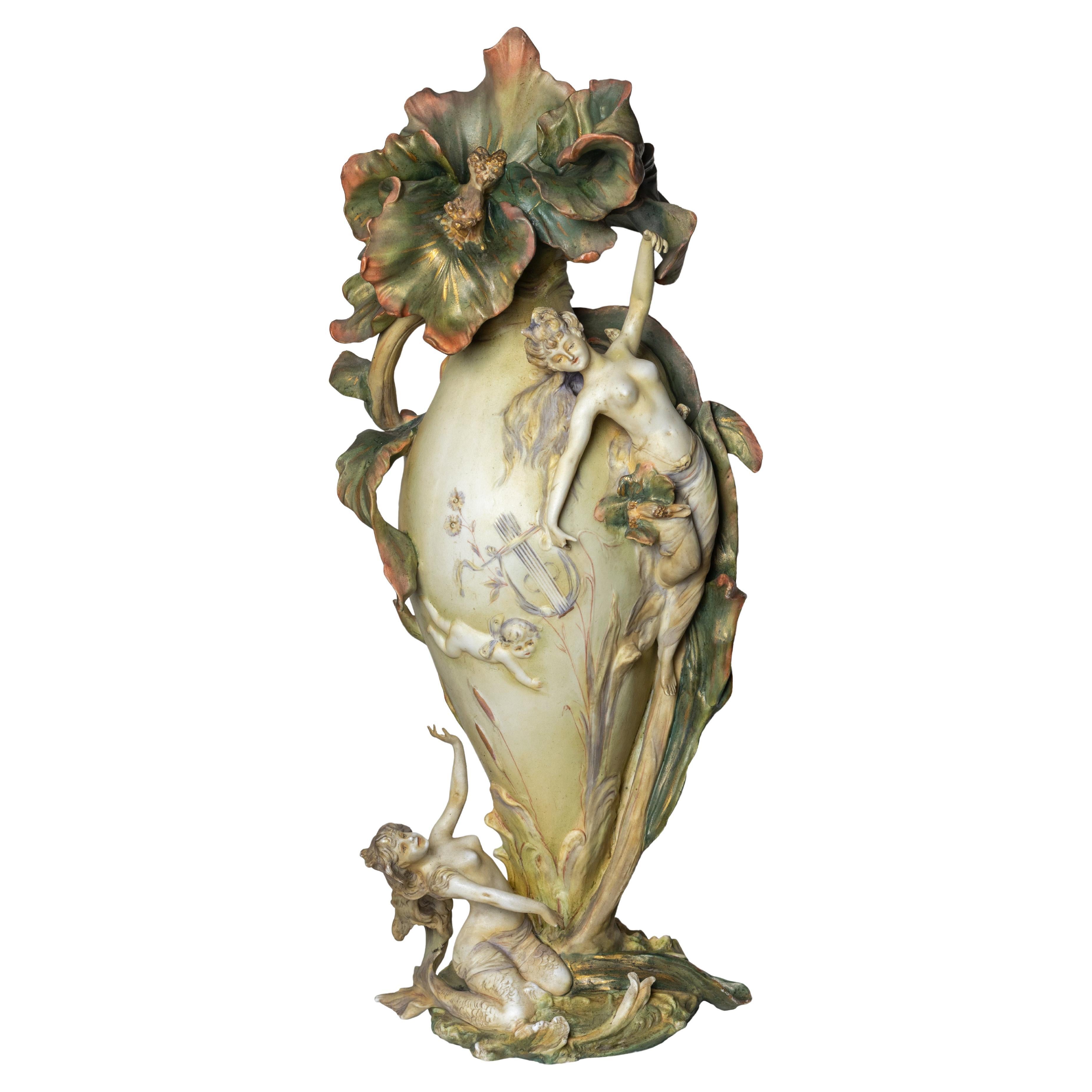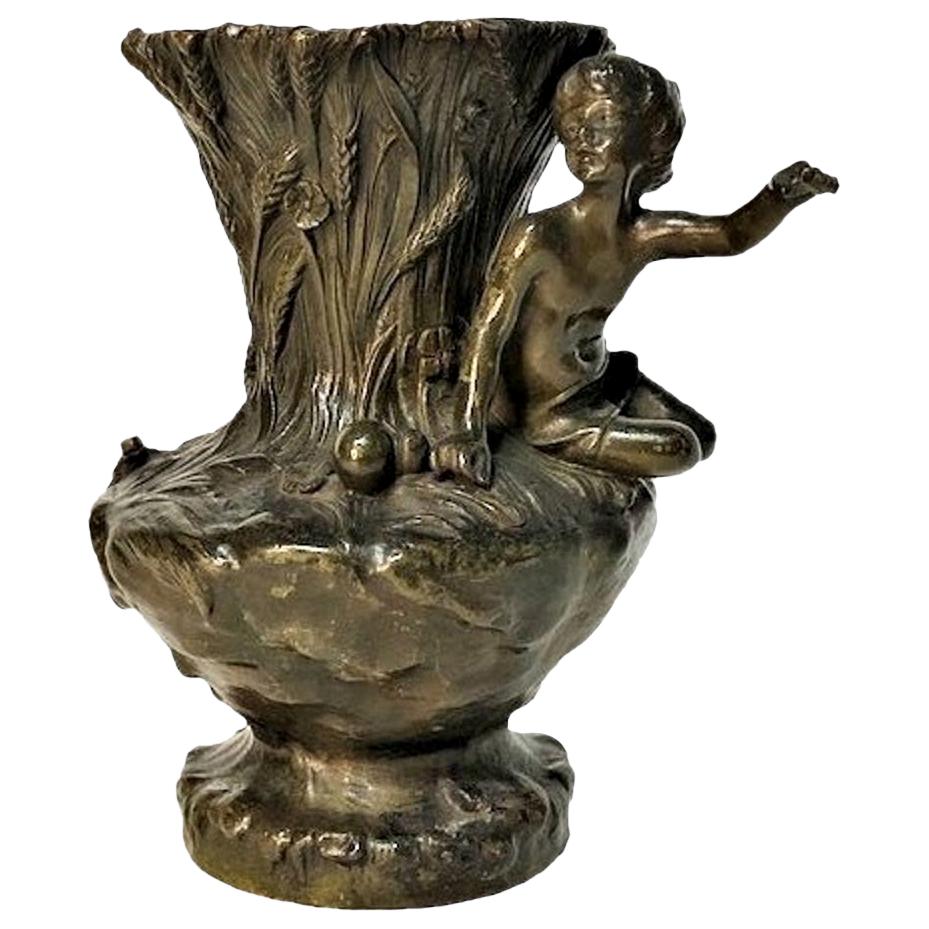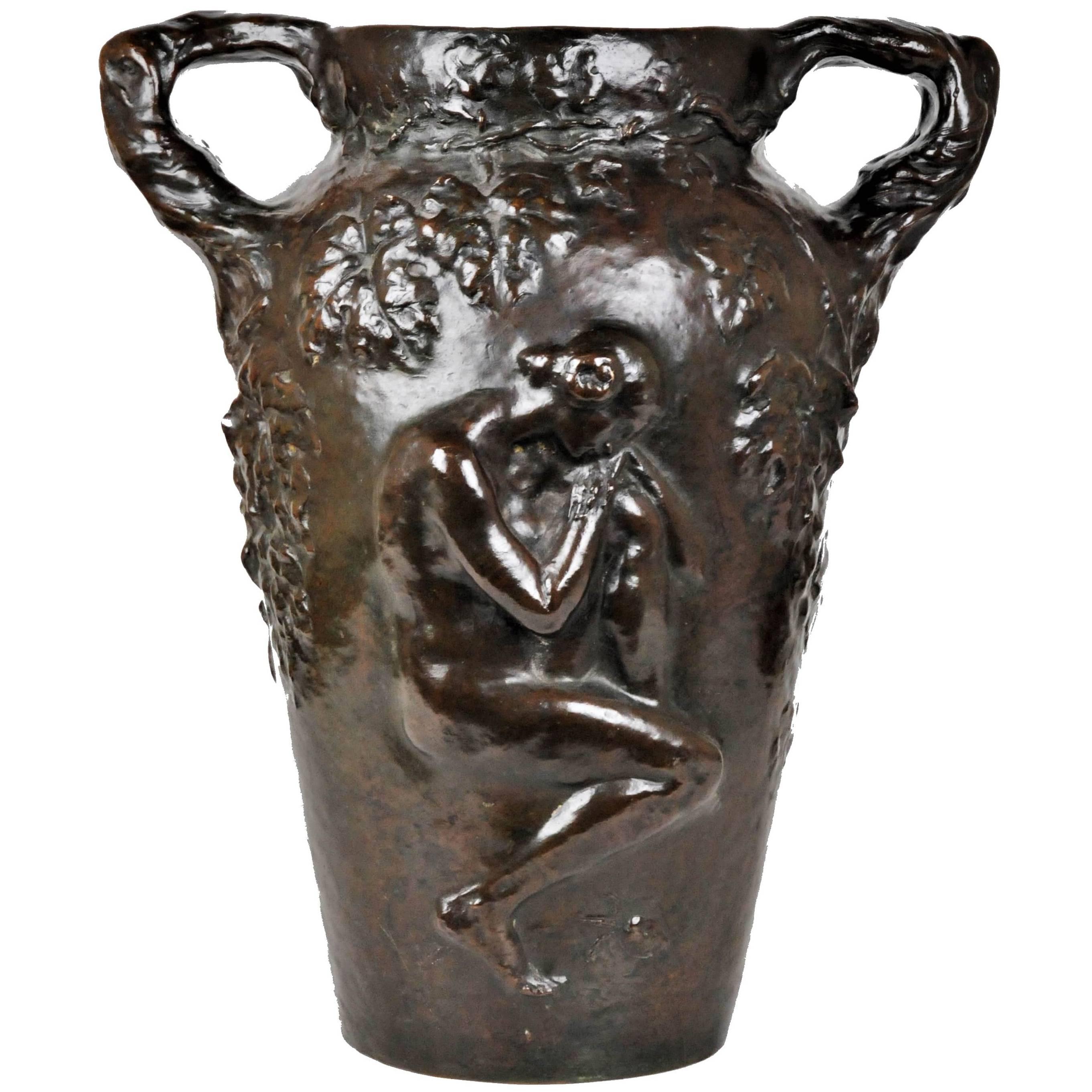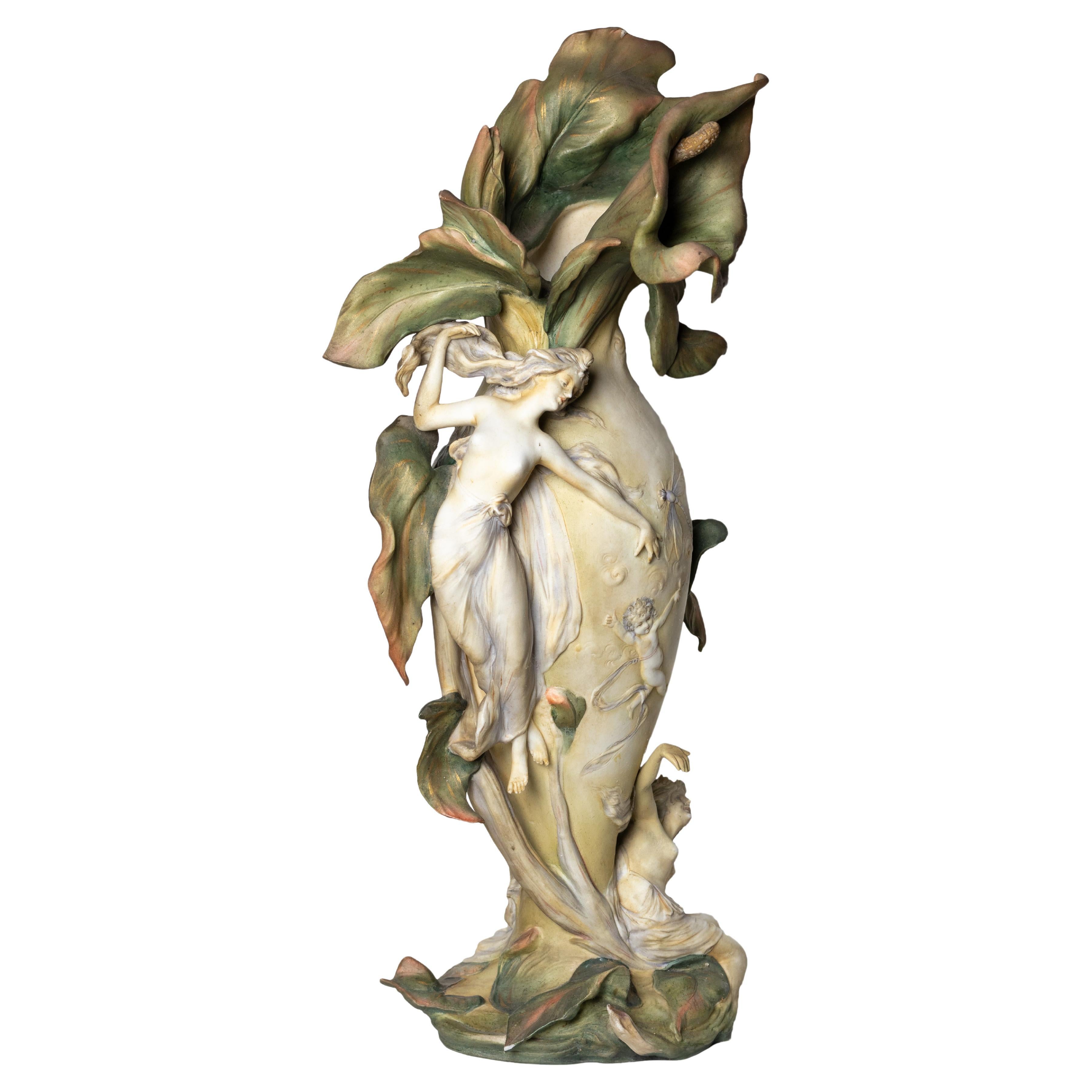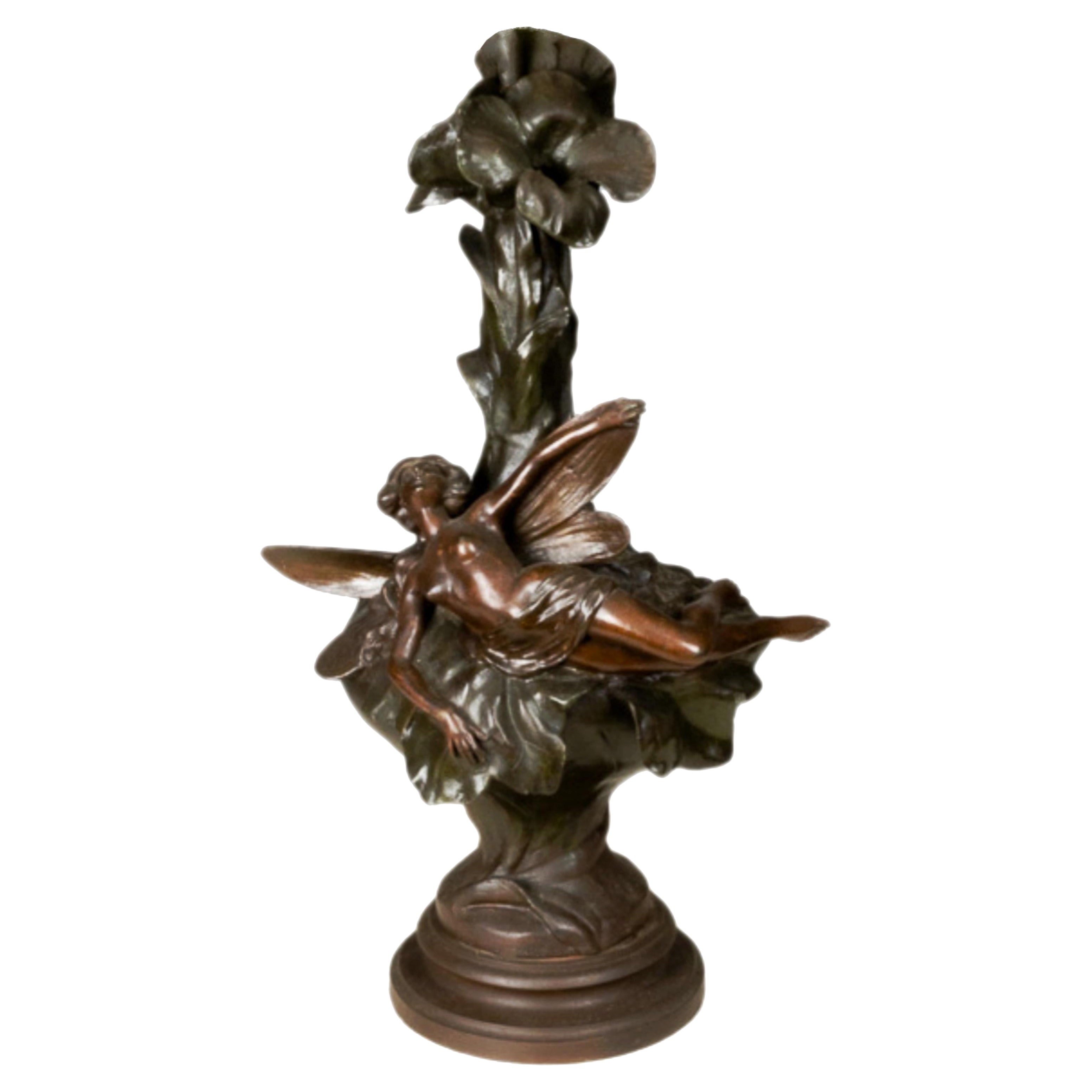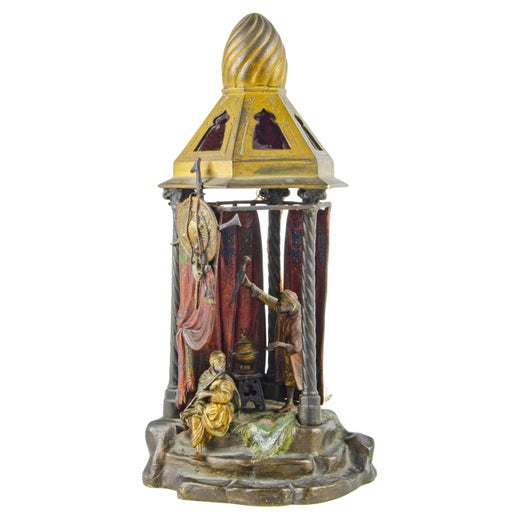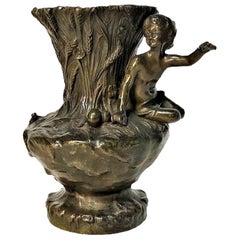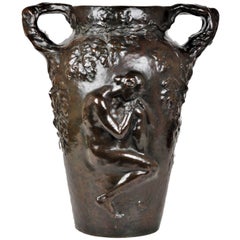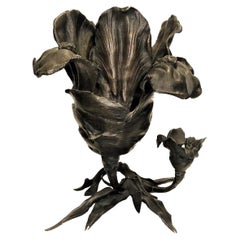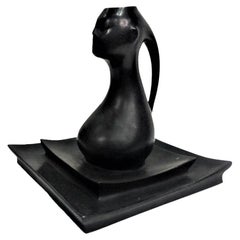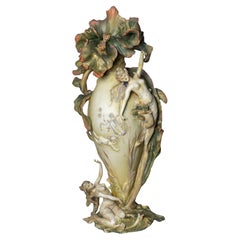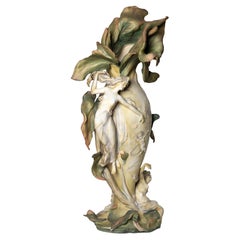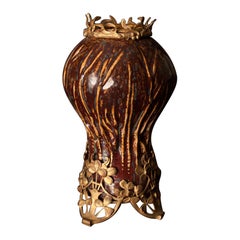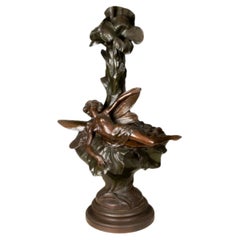Items Similar to Franz Xavier Bergmann, Sculptural Bud Vase, Vienna Bronze, circa 1900
Want more images or videos?
Request additional images or videos from the seller
1 of 13
Franz Xavier Bergmann, Sculptural Bud Vase, Vienna Bronze, circa 1900
$2,200
£1,669.63
€1,923.17
CA$3,143.82
A$3,450.31
CHF 1,779.42
MX$41,216.46
NOK 22,548.58
SEK 21,129.07
DKK 14,362.43
About the Item
Dimensions
Height: 7.25 inches
Width: 5.25 inches
Depth: 4.5 inches.
Markings
Fully marked on the bottom with a "B" in an urn-shaped cartouche (for “Bergmann”), and “GESHUTZED” (German: “PROTECTED).
ABOUT
What distinguishes this unique bud vase from others is a perfect synthesis of a utilitarian object and a Fine sculpture. It is not only the amazing subtlety and taste of the author’s artist skills, but an extraordinary design and an absolutely outstanding original plot. Designed for a single flower only, it is nonetheless a very complex and multifaceted composition filled with warm humor and fantasy. Sitting on a vessel shaped as a gourd, clasping its goat legs with hooves and holding on to the neck with one hand in order not to fall of it; a playful and mischievous faun holds by the tail a fleeing lizard with the other hand.
FRANZ XAVIER BERGMANN (Austrian, 1861–1936) was the owner of a Viennese foundry who produced numerous patinated and cold-painted bronze oriental, erotic and animal figures, the latter often humanized or whimsical, humorous objects d'art. Cold painted bronze refers to pieces cast in Vienna and then decorated in several layers with so-called dust paint; the expertise for the mix of this kind of paint has been lost. The color was not fired hence "cold painted". Mainly women working at home, a typical cottage industry, carried out the painting. Noted for his detailed and colorful work, Bergmann was signing his creations with either a "B" in an urn-shaped cartouche, or "Nam Greb" - for "Bergman" in reverse. These marks used to disguise his identity on the erotic works. Often, the sculptures are also marked with model number and stamped “GESHUTZED” (German for “PROTECTED”).
- Creator:Franz Bergmann (Maker)
- Dimensions:Height: 7.25 in (18.42 cm)Width: 5.25 in (13.34 cm)Depth: 4.5 in (11.43 cm)
- Style:Jugendstil (Of the Period)
- Materials and Techniques:Bronze,Patinated
- Place of Origin:
- Period:1900-1909
- Date of Manufacture:circa 1900
- Condition:Wear consistent with age and use. We make our best effort to provide a fair and descriptive condition report. Please examine photos attentively, as they are part of the description. Send us a message to request more details or discuss price.
- Seller Location:New York, NY
- Reference Number:1stDibs: LU2819333240892
Franz Bergmann
There were many bronze foundries operating in Vienna in this period, but it was Bergman’s which became the most celebrated, working with a number of celebrated Viennese sculptors at the turn of the 20th Century, such as Bruno Zach, to produce designs for his famous bronze figures. Bergman bronzes are especially famous for having utilised a technique for decorating the bronzes called cold painting. Cold painting as a technique developed in Vienna in the late 19th Century, and involved the application of several layers of paint added to the bronze after firing. It was used to make fashionable collectors’ items. Bergman figures came in three main forms: animal figures, Orientalist sculptures, and erotic figures in the Art Nouveau style. His animal figures were often whimsical and humorous, and often satirical. They have become highly sought-after collectors’ items today. Bergman’s Orientalist sculptures are equally highly sought-after. He was producing these figures at a time when interest in the exotic lands of the Middle East and North Africa was at its peak among Europe’s artists and buyers.
About the Seller
5.0
Gold Seller
Premium sellers maintaining a 4.3+ rating and 24-hour response times
Established in 1993
1stDibs seller since 2017
87 sales on 1stDibs
Typical response time: 5 hours
- ShippingRetrieving quote...Shipping from: New York, NY
- Return Policy
Authenticity Guarantee
In the unlikely event there’s an issue with an item’s authenticity, contact us within 1 year for a full refund. DetailsMoney-Back Guarantee
If your item is not as described, is damaged in transit, or does not arrive, contact us within 7 days for a full refund. Details24-Hour Cancellation
You have a 24-hour grace period in which to reconsider your purchase, with no questions asked.Vetted Professional Sellers
Our world-class sellers must adhere to strict standards for service and quality, maintaining the integrity of our listings.Price-Match Guarantee
If you find that a seller listed the same item for a lower price elsewhere, we’ll match it.Trusted Global Delivery
Our best-in-class carrier network provides specialized shipping options worldwide, including custom delivery.More From This Seller
View AllFrench Beaux Arts, Patinated Bronze Figural Vase by A. Bofill, Ca. 1900
By Antoine Bofill
Located in New York, NY
Antoine Bofill (Spanish-French, 1875-1925) was a Spanish artist and member of the Animalier movement of the 19th century. Best known for his small, decorative bronze sculptures, Bofi...
Category
Antique Early 1900s French Beaux Arts Vases
Materials
Bronze
Charles Vital-Cornu, French Art Nouveau Bronze Sculptural Floral Vase, 1900s
By Charles Vital-Cornu
Located in New York, NY
Charles Vital-Cornu (French, 1851 - 1927), Jouffroy’s and Pils’ pupil, he acquired a skillfulness mastery in carving marbles and producing bronzes. He used several patinas in his production. Indeed, if his pieces' embodiments are often golden-brown colored, the hollow part are darker. His figures, hands, faces, and bodies are of a great quality.
Charles Vital-Cornu had participated in numerous annual ‘‘Salons’’ organized in Paris by ‘‘la Société des Artistes Français’’ where he got several awards, such as a mention of Honor in 1880 and 1881, a third class medal in 1882, a travelling grant in 1883, a second class medal in 1886, a bronze medal at the 1889 World Fair and, finally, a silver medal at the 1900 World Fair at the Grand palace...
Category
Antique Early 1900s French Art Nouveau Vases
Materials
Bronze
$4,675 Sale Price
44% Off
French Art Nouveau Patinated Bronze Sculptural Iris Vase, ca. 1900
Located in New York, NY
ABOUT IRIS
The iris is a special and mysterious flower. Not only because of its striking appearance, but also from an artistic and historical point of view. It is also like a work of art, as though created by Mother Nature. The unique leaves of this plant not only create wonderful shadow casts, but also look as if they were painted by hand. It's no wonder that iris acts as the muse for countless artists, and can be seen in many famous works of art.
The iris was first spotted in the time of Pharaoh Thutmose, in 1504 BC. He had the iris inscribed into the wall reliefs of a temple as a sign of his power, as well as decorating his sceptre with motifs of the flower. Since then, the iris has been a symbol of victory in Egypt. But the symbolism of the iris goes further than that. In Japan, the flower represents courage and is the symbol of the boys' festival. In Islamic cultures, the iris is a symbol of prosperity. In Europe, the flower was a popular weapon symbol in the Middle Ages and stood for chivalry. And in Christianity, the iris was seen as a symbol of the trinity because of its three-part flowers. With more than 300 varieties, the iris is now the most popular flower among growers and gardeners following the rose.
Countless artists use the iris in their works and the flower is present in all eras. You can see the flower on furniture, vases, jewelry, fabrics, sculptures, coats of arms and much more. Did you know that the iris is also called the sword lily? It's not a coincidence that it used to symbolize physical and emotional pain and suffering caused by a weapon. We also see the flower in religious art, where it's often associated with Mary and Jesus. The iris is also associated with the Greek goddess Iris, where the flower symbolizes reconciliation and divine messages. This is also reflected in many paintings.
Finally, the iris is also visible in Dutch and Flemish still-life paintings. This can be in a religious form, incorporated into an object or as a decorative flower.
In the Art Nouveau art movement, the iris (along with other plants, such as the birch) was often used as an expression of feminine beauty. With its almost otherworldly appearance, the iris is perfectly suited to the Art Nouveau aesthetic and is featured in many well-known works of art. The poet of that era, Hermann Hesse...
Category
Antique Early 1900s French Art Nouveau Planters, Cachepots and Jardinières
Materials
Bronze
Alfonso Canciani, Viennese Secession Orientalist Bronze Vase, c. 1910
By Alfonso Canciani
Located in New York, NY
Alfonso Canciani (Italian-Austrian, 1863-1955) was a famous Italian-Austrian sculptor of the period of accession to the Viennese Secession. Son of a stonemason, after a realist period he managed to establish himself as a leading sculptor of the Viennese Secession. In fact, he worked in Vienna, where he had enrolled in 1886 at the Academy of Fine Arts, then at the Higher School of Sculpture and finally at the Special School, where he obtained the Rome prize for the sketch for Dante's Monument.
He developed a notable business obtaining important prizes and numerous commissions. First among the sculptors of the Viennese capital, he was invited to join the Association of the Viennese Secession, of which Klimt was magna pars, after the exhibition of Dante's group in 1900 at the Secession exhibition, and obtained the most important Austrian artistic prize, the Kunstlerlpreis.
This same work, presented in 1910 in Berlin, at the Great Art Exhibition, also received an important recognition here. He obtained the Rome prize in 1896, exhibited successfully in Munich and in 1899 at the III International Art Exhibition in Venice.
In that period he made some statues of saints for the cathedral of Santo Stefano in Vienna, the monument to Wagner, the bust of Nietzsche for the University, the scepter and the gold chain of the University Rector, figures of Italian poets ( Petrarch, Boccaccio, Tasso, Ariosto).
He submitted a sketch for the official monument to Empress Elizabeth, which was then built in Austrisn Gföhl and Pula. At the time of his accession to the Secession, he dedicated himself to decorating the facade of the Artaria house in Vienna in collaboration with the architect Max Fabiani.
He later abandoned the symbolist decorativism of the Jugendstil for a more concentrated and vigorous style, approaching the Belgian sculptor Constantin Meunier for the theme of work, and preferring to exhibit at the Künstlerhaus.
In Vienna, he was generous with advice and help with the Italians and in particular with his fellow citizens (such as the Brazzanese Luigi Visintin, then a university student).
After the First World War, he returned to Italy and lived in Friuli, penalized by the fact that the Habsburg Empire had by now disappeared. Instead of large-scale public monuments, he then devoted himself to engraving medals (e.g. for Benedict XV and for the Italian mission in Vienna in 1919) and to designing funeral monuments (examples in Mali Lošinj and Trieste) and portrait busts (of Generals Carlo Caneva and Antonio Baldissera in Udine, sculptures of the War Memorial of Corno di Rosazzo). After all, he had already executed the Bab grave monument in the Döblinger cemetery in Vienna in 1909.
He taught in Trieste from 1920 until 1935, at the local school of industrial art, where he had Marcello Mascherini...
Category
Vintage 1910s Austrian Jugendstil Vases
Materials
Bronze
Austrian Jugendstil Vienna Bronze Sculptural Paperweight by Carl Fiala, ca. 1910
Located in New York, NY
ABOUT
This elegant Austrian Jugenstil sculptural desk paperweight depicts some fantastic half-human creature from the underwater world, riding a snail. Signed C. Fiala, dark-green co...
Category
Vintage 1910s Austrian Jugendstil Paperweights
Materials
Bronze
Paul Dachsel for Turn Teplitz, Austrian Jugenstil Ceramic ‘Fern’ Vase, ca. 1900
By Paul Dachsel
Located in New York, NY
DETAILS:
Fully marked on bottom.
DIMENSIONS:
height: 6.75 inches, width: 4.5 inches, depth: 4.5 inches
ABOUT THE ARTIST
Paul Dachsel (Czech, born circa 1880) was the son-in-law of Alfred...
Category
Antique Early 1900s Austrian Art Nouveau Vases
Materials
Ceramic
You May Also Like
German Art Nouveau Vase By Karl Ens Volkstedt, Late 19th Century
By Karl Ens
Located in Lisbon, PT
A Jugendstil Style amphora from Rudolstadt, Thuringia hailing from the Triebner Ens Manufacture and the artist Karl Ens Volkstedt.
A vase decorated with an iris flower form neck an...
Category
Antique Late 19th Century German Jugendstil Vases
Materials
Faience
$3,530 Sale Price
30% Off
Art Nouveau Vase By Karl Ens Volkstedt, Jugendstil, Circa 1896
By Karl Ens
Located in Lisbon, PT
An amazing Jugendstil Style amphora from Rudolstadt, Thuringia hailing from the Triebner Ens Manufacture and the artist Karl Ens Volkstedt.
A vase decorated with a iris flower form...
Category
Antique Late 19th Century German Jugendstil Vases
Materials
Faience
$3,530 Sale Price
30% Off
Art Nouveau Gourd Vase with Brass Mount by Pierre-Adrien Dalpayrat & Marcel Bing
By Marcel Bing, Pierre-Adrien Dalpayrat
Located in Chicago, US
PIERRE-ADRIEN DALPAYRAT (1844-1910) After working nearly half his life as an itinerant faience painter and directing production for commercial porcelain manufacturers, Dalpayrat’s ey...
Category
Antique Early 1900s Art Nouveau Vases
Materials
Brass
Art Nouveau Sculpture Vase: Enchanting Fairy, Circa 1897
Located in Lisbon, PT
A graceful fairy, reminiscent of Germanic mythology, resting on a blooming water lily vase.
The sculpture's intricate details and flowing lines exemp...
Category
Antique Late 19th Century Art Nouveau Vases
Materials
Metal, Brass, Zinc
$2,342 Sale Price
36% Off
Pierre-Adrien Dalpayrat "Colocynth" Glazed Ceramic Vase
By Pierre-Adrien Dalpayrat
Located in New York, NY
A two tiered "Colocynth" ceramic vase by Pierre-Adrien Dalpayrat featuring his celebrated, earthen tone glazes in hues of turquoise, burgundy, moss an...
Category
Early 20th Century French Art Nouveau Vases
Materials
Ceramic
Early 20th Century Bronze "Art Nouveau Vase with Frogs" by Jean Dunand
By Jean Dunand
Located in London, GB
An excellent French early 20th Century bronze vase decorated with raised frogs upon lily pads around the circumference. The bronze with very fine deep brown patina and fabulous detai...
Category
Early 20th Century French Art Nouveau Vases
Materials
Bronze
More Ways To Browse
Goat Leg
Gold Bud Vases
Bronze Bud Vase
Andersson Johansson Hoganas
Large Clay Vase
Louis Comfort Tiffany Favrile
Murano Glass Red Green
Pink And Gold Vase
Rosenthal White Modern
Royal Copenhagen Vase Brown
Spill Vase
Teal Vase
Vases With Lions
Amphora Italy
Canton Vase
Chamotte Vases
Mcm Vase
Murano Sommerso Vase Mandruzzato
